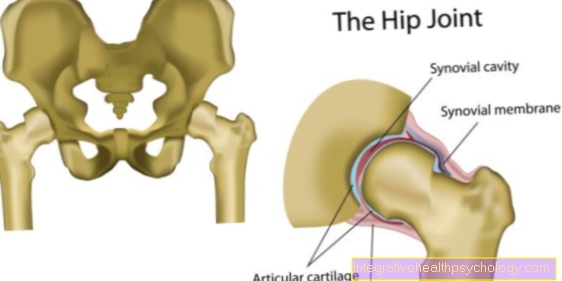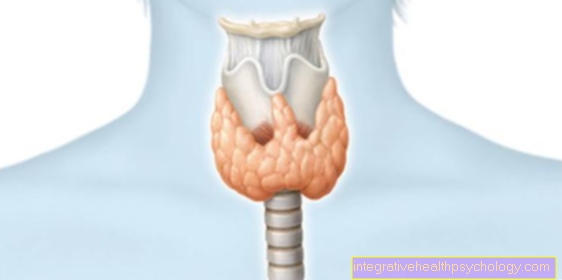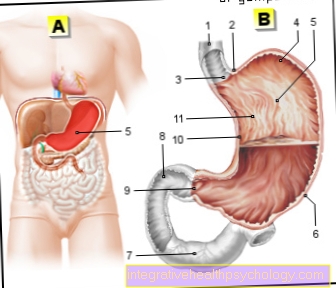Side effects of the flu shot
introduction
A number of side effects can occur with the flu shot. Most are due to a local or systemic inflammatory response to the vaccine and last a maximum of two to three days. As a rule, they do not have any long-term complications. More serious side effects are usually caused by allergies.
These can be directed against various ingredients in the flu vaccine. Allergies can also manifest themselves as local reactions, in the worst case they trigger an anaphylactic shock.

These are the typical side effects of a flu shot
The typical side effects of a flu vaccination are based on the one hand on the local reaction of the body to the vaccination. This includes the reddening of the puncture site and swelling. Pain at the injection site and / or in the muscle into which the vaccine was injected is also not uncommon. Diarrhea can also be caused by a flu shot.
If the whole body reacts to the vaccination, it leads to tiredness, fatigue, fever and sometimes also aching limbs. Allergies to ingredients of the vaccination can also trigger allergic reactions up to a severe life-threatening anaphylactic shock.
Redness
The redness after a flu shot usually occurs immediately on and around the injection site. It is based on a local immune response in the body to the flu vaccine. A particularly large number of immune cells are washed into the area of the puncture site because there is a very high dose of the vaccine there. To get all the immune cells there, increased blood flow is necessary.
This increased blood flow is also noticeable in the smallest superficial blood vessels, so that the skin becomes reddened. The reddened area is usually also warmed up. The overheating is also due to the immune reaction. The body tries to reach a temperature that harms the invading virus. So it should be weakened and the immune defense should be facilitated.
swelling
The swelling is usually a local phenomenon at the puncture site, which lasts for about two to three days. Most of the time, the tissue around the puncture site is not only swollen, it also feels much firmer than the tissue around it.
The swelling comes from the body's local response to the flu vaccine. A large number of immune cells are necessary for the vaccine, which the body classifies as a potentially threatening pathogen, to be sufficiently attacked by the immune system.
These usually reach the injection site through increased blood flow. Along with the cells, however, a lot of fluid is also transported into the tissue, causing swelling there.
Pain
The pain after the flu vaccination usually only affects the injection site itself for a short time. Most of the time, however, the muscle into which the flu vaccine was injected is also weakened for a few days. In addition, every movement and tension of the muscle is painful. The feeling is comparable to a strong sore muscles.
This side effect of the flu vaccination is also based on the desired effect that the immune system deals with the vaccine and fights it. An inflammatory reaction occurs both on the surface and deeper in the muscle (see also: Inflammation of the muscles) caused by the immune response to the flu vaccine.
In the process, messenger substances are released that are supposed to call up additional immune cells. However, these messenger substances simultaneously trigger a signal on the pain-conducting nerve fibers, which arrives in the brain and is registered there as pain.
Inflammation at the injection site
The inflammation at the puncture site is desirable to some degree as it reflects the immune response to the flu shot. This can lead to the typical five symptoms of inflammation: reddening, swelling, overheating, pain and impaired functionality of the affected tissue. In the case of light contamination, however, there may also be a real inflammation of the injection site, which is not caused by the vaccine.
For example, if the skin is not properly disinfected, superficial skin germs (especially the bacterium Staphylococcus aureus) can get into the deeper layers of the skin and cause inflammation there. This usually lasts longer and manifests itself more strongly than a pure reaction to the vaccine.
allergy
You can be allergic to various ingredients in the flu vaccine. The most common is the allergy to egg white. This plays an important role, since the flu vaccines are made from fertilized chicken eggs and can therefore contain traces of chicken protein.
An allergic reaction, on the other hand, can take on all forms, from mild symptoms consisting only of a slightly increased local inflammatory reaction to a skin rash with itching and dangerous anaphylactic shock.
You might also be interested in this article: Itchy rash
Anaphylactic shock
Anaphylactic shock is the worst form of allergic reaction to an allergen. Contact with the allergen - in the case of the flu vaccine, this is one of the many ingredients in the vaccine - triggers an extreme reaction of the immune system. There is an excessive release of various messenger substances and immune signals.
In the case of an anaphylactic shock, this leads to a destabilization of the circulatory system up to a real circulatory shock, which manifests itself in extremely low blood pressure and a greatly increased pulse. In addition, the mucous membranes in the airways can swell so much that it leads to life-threatening shortness of breath.
Below you might be interested in the various causes of shortness of breath. To do this, read the following article: Shortness of breath
You can also find more detailed information on this topic at: Anaphylactic shock
diarrhea
In addition to local and systemic inflammatory reactions, a flu shot can also cause symptoms such as diarrhea. This side effect is also ultimately due to the immune reaction. When the immune system is recruited against the flu vaccine, many different messenger substances are released. These lead to changes in the balance in the hormonal balance.
Some of the hormones affected are responsible, among other things, for regulating the water balance. If only a little water is absorbed by these hormones around the intestines and a lot of water is released from the body, the typical thin, watery stool occurs. By definition, however, one speaks of diarrhea only when both the consistency and the stool frequency have changed significantly.
Fever after vaccination
After the flu vaccination, systemic reactions of the immune system occur in addition to local inflammatory reactions. Fever is one of the body's most powerful defense mechanisms. The immune system identifies the processed viruses from the flu vaccine as potentially threatening pathogens.
Since most pathogens are mainly made up of proteins, their function is heavily dependent on the prevailing ambient temperature. Therefore, the body tries to make the environmental conditions for the pathogens as negative as possible and increases the body temperature. So the fever comes about as a side effect of the flu vaccination. Usually it lasts for a maximum of two to three days.
For more information about the causes of the development of fever in the human organism, see the article: Causes of fever
Headache and body aches (muscle pain)
Headaches and body aches are typical symptoms of the flu. They can also occur in a weakened form with the flu vaccination. The flu vaccination is carried out with processed and thus weakened flu viruses so that the body gets to know the surface structure of the pathogens. The immune system is activated in the same way as it would with the real flu.
However, since it is a weakened pathogen, the physical reaction is nowhere near as pronounced as with the flu. However, symptoms such as fever, fatigue, headache and body aches can occur. Muscle pain is also typical, particularly in the muscle where the flu vaccine was injected.
Guillain-Barré Syndrome
Guillain-Barré Syndrome (GBS) is an inflammatory nerve disease. The nerves can be temporarily damaged after an infection, for example. The nerve roots that emerge from the spinal cord are particularly affected by the inflammatory changes.
The main symptom is paralysis, which begins in the legs and continues to rise. Due to the inflammatory cause of the disease, GBS was also discussed as a possible consequence of the flu vaccination. However, no association between GBS and vaccination was found.
Read more on the subject below: Guillain-Barré Syndrome







.jpg)




















.jpg)
.jpg)